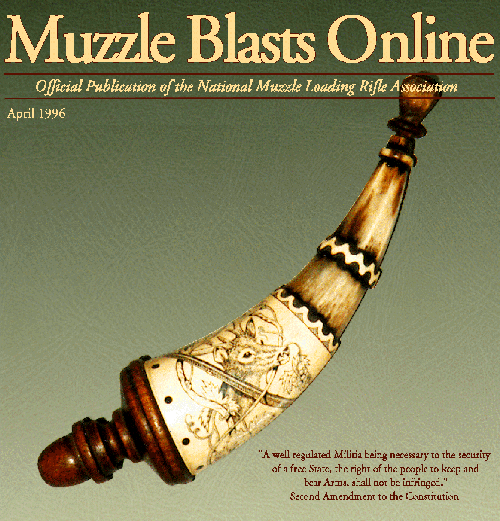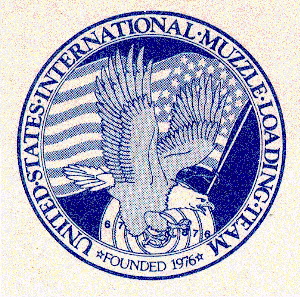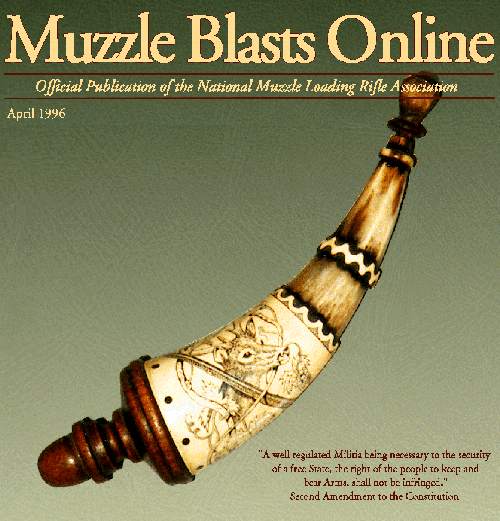|
Muzzle Blasts Online |
|
...for the muzzleloading enthusiast |
|
The muzzleblasts.com domain, subdomains, content, etc., are neither affiliated with the NMLRA nor its paper magazine Muzzle Blasts |
|
Muzzle Blasts Online |

|
|
|
|
|
|
A note from the USIMLT
(U.S. International Muzzle Loading Team)

|
Slightly earlier (in the 1930s), the founders of the National Muzzle Loading Rifle Association held their first shooting matches. The Muzzle Loaders Association of Great Britain began holding shooting competition at the historic Bisley Range outside London in the early 1950s, and the French began to shoot old rifles at the Tir National de Versailles in the early 1960s. Italy joined the growing group of clubs shooting antique muzzleloaders competitively in 1967, matching their skills against France, and in 1969 the Germans began competitive muzzleloading by holding the first of what was to become a popular yearly event at Schwabisch Hall.
The French took the initiative in 1971 to arrange the first international championship. During this event, held at Vaudoy-en-Brie, a rough set of common rules was established and accepted, and the decision was made to found the Muzzle Loaders Association International Committee (MLAIC), based on the growing popularity of the sport. Great Britain, Germany, Italy, France, and two representatives from the United States were in attendance. The first official MLAIC world championship was held in Madrid, Spain, the following year, with 32 participants from Great Britain, Germany, Italy, and Spain. The same countries again met in 1973 to compete at the second world championship in Bisley, England. Denmark joined the group of 83 shooters, and clay pigeon events were introduced for the first time at this competition.
In 1974, the MLAIC world championships moved to Schwabisch Hall, Germany, with the addition of Netherlands and Switzerland to the roster of competing nations. With a total of more than 100 shooters participating, this was the last all-European event. The Italian Federation hosted the competitions in 1975 in Codogno, Italy, in the heart of the muzzleloading replica manufacturing district, with South Africa and Austria participating as new members.
Our nation had much to celebrate in 1976. In September, the fledgling U.S. International Muzzle Loading Team (USIMLT) competed for the first time within the MLAIC. The first official American team, the ``Bicentennial Squad,'' turned in an exemplary performance, setting two new world records and winning the coveted grand aggregate cup, the Grand Prix de Versailles. Japan also participated for the first time in 1976, with the total number of shooters having grown to 176.
That was just the beginning, and the USIMLT has been attending world championships or zone (regional) championships every year since them. In 1985, because of ever-escalating travel costs, the MLAIC voted that year to hold world championship matches ever other year instead of annually. However, to maintain continuity and momentum within the program, the decision was made to divide the member nations into two zones for the purpose of holding smaller competitive programs in the alternate years. The United States has been host to the Pacific Zone, which includes the U.S., Australia, Canada, Japan, New Zealand, South Africa, and Venezuela, for each of these zone events held so far.
The U.S. Team traveled to Chur, Switzerland, for the sixteenth world championship in 1994, where competition was extremely keen and scores rose higher yet in individual events. The number of active member nations had risen to 20, with an additional three correspondent nations, and total competitors numbered 490.
Not only has the MLAIC grown in size and scope since its beginning, so too has the American team. Although the world championships originally were shot primarily with antique firearms only, the introduction of replica categories for each of the individual events in 1983 has caused the size of the U.S. team nearly to double from that first small group of 17 in 1976. The final qualification program utilized for team selection sees over 100 participants contending for a position and the privilege of representing our country in competition.
The United States International Muzzle Loading Committee (USIMLC) was created and incorporated as a nonprofit organization in 1976 for the specific purpose of fielding an American team of shooters to participate in the competition of the Muzzle Loaders Association International Committee (MLAIC) held annually. The USIMLC is ultimately responsible for the selection of American residents, through shooting tryouts, to participate as members of the United States International Muzzle Loading Team in all MLAIC and USIMLC muzzleloading championships.
The individual U.S. team competitor represents members of all muzzleloading clubs and organizations in the country. Each prospective team member must successfully complete both a preliminary and final tryout program before becoming a member of the USIML Team. These top shooters are then named for individual competition in the upcoming world muzzleloading championships and zone championships at the close of the final qualification program.
Because the United States International Muzzle Loading Team depends solely on contributions of funds and supplies from shooting organizations, clubs, manufacturers, dealers, and so forth, it is no small undertaking on the committee's part to provide needed funding to send their U.S. Team forth into competition. Each shooter representing the United States must receive air and land transportation and housing during World Championship Matches, as well as be presented in both dress and shooting uniforms identifying him or her as a competitor of our country. In addition, each shooter must have the proper equipment and accoutrements. Fund-raising for the U.S. Team presently embraces promotional and advertising formats. The individual serving on the U.S. Committee works untiringly and without monetary compensation toward the success of the overall team.
The fine records established by the United States team since their first competitions in the Muzzle Loaders Association International Committee in 1976 has given credence to superior shooting in the use of original antique and replica muzzleloading firearms. The United States International Muzzle Loading Team was, from the beginning, and still is a winning team.
USIMLT Gold in 1998
The United States International Muzzle Loading Team is still looking for a few good shooters for the 1997-98 U.S. team. Preliminary tryouts have taken place for the 1996 U.S. team during the NMLRA's National Championship Shoot and the National Fall Shoot at Friendship this past year, and will continue this year for the 1997-98 team. Now is the time to start acquiring the three scores per event that you need to qualify for that team.
The USIMLT officer in charge of preliminary tryouts at Friendship is Russ Combs [6981 S.Co.Rd. 600 E, Plainfield, IN 46186; (317) 839-8273]. You may contact him at the 1996 National Championship Shoot, June 8-16, to shoot preliminary tryout scores for a position on the next U.S. team.
If you are unable to attend that shoot, you may contact Tom Henley of Vestal, New York, who is the officer in charge of all preliminary matches in the United States. His telephone number is (607) 754-7968. Tom will come up with a way to get you qualified for final 1997-98 team tryouts if at all possible.
We should be winning all of the events at the world championships, but we're not. We are a country made up of shooters, and we need your help to bring home the gold!
